Wentao Liu
Harmonizing Visual Representations for Unified Multimodal Understanding and Generation
Mar 27, 2025Abstract:Unifying visual understanding and generation within a single multimodal framework remains a significant challenge, as the two inherently heterogeneous tasks require representations at different levels of granularity. Current approaches that utilize vector quantization (VQ) or variational autoencoders (VAE) for unified visual representation prioritize intrinsic imagery features over semantics, compromising understanding performance. In this work, we take inspiration from masked image modelling (MIM) that learns rich semantics via a mask-and-reconstruct pre-training and its successful extension to masked autoregressive (MAR) image generation. A preliminary study on the MAR encoder's representation reveals exceptional linear probing accuracy and precise feature response to visual concepts, which indicates MAR's potential for visual understanding tasks beyond its original generation role. Based on these insights, we present \emph{Harmon}, a unified autoregressive framework that harmonizes understanding and generation tasks with a shared MAR encoder. Through a three-stage training procedure that progressively optimizes understanding and generation capabilities, Harmon achieves state-of-the-art image generation results on the GenEval, MJHQ30K and WISE benchmarks while matching the performance of methods with dedicated semantic encoders (e.g., Janus) on image understanding benchmarks. Our code and models will be available at https://github.com/wusize/Harmon.
NADER: Neural Architecture Design via Multi-Agent Collaboration
Dec 26, 2024



Abstract:Designing effective neural architectures poses a significant challenge in deep learning. While Neural Architecture Search (NAS) automates the search for optimal architectures, existing methods are often constrained by predetermined search spaces and may miss critical neural architectures. In this paper, we introduce NADER (Neural Architecture Design via multi-agEnt collaboRation), a novel framework that formulates neural architecture design (NAD) as a LLM-based multi-agent collaboration problem. NADER employs a team of specialized agents to enhance a base architecture through iterative modification. Current LLM-based NAD methods typically operate independently, lacking the ability to learn from past experiences, which results in repeated mistakes and inefficient exploration. To address this issue, we propose the Reflector, which effectively learns from immediate feedback and long-term experiences. Additionally, unlike previous LLM-based methods that use code to represent neural architectures, we utilize a graph-based representation. This approach allows agents to focus on design aspects without being distracted by coding. We demonstrate the effectiveness of NADER in discovering high-performing architectures beyond predetermined search spaces through extensive experiments on benchmark tasks, showcasing its advantages over state-of-the-art methods. The codes will be released soon.
ShotVL: Human-Centric Highlight Frame Retrieval via Language Queries
Dec 17, 2024Abstract:Existing works on human-centric video understanding typically focus on analyzing specific moment or entire videos. However, many applications require higher precision at the frame level. In this work, we propose a novel task, BestShot, which aims to locate highlight frames within human-centric videos via language queries. This task demands not only a deep semantic comprehension of human actions but also precise temporal localization. To support this task, we introduce the BestShot Benchmark. %The benchmark is meticulously constructed by combining human detection and tracking, potential frame selection based on human judgment, and detailed textual descriptions crafted by human input to ensure precision. The benchmark is meticulously constructed by combining human-annotated highlight frames, detailed textual descriptions and duration labeling. These descriptions encompass three critical elements: (1) Visual content; (2) Fine-grained action; and (3) Human Pose Description. Together, these elements provide the necessary precision to identify the exact highlight frames in videos. To tackle this problem, we have collected two distinct datasets: (i) ShotGPT4o Dataset, which is algorithmically generated by GPT-4o and (ii) Image-SMPLText Dataset, a dataset with large-scale and accurate per-frame pose description leveraging PoseScript and existing pose estimation datasets. Based on these datasets, we present a strong baseline model, ShotVL, fine-tuned from InternVL, specifically for BestShot. We highlight the impressive zero-shot capabilities of our model and offer comparative analyses with existing SOTA models. ShotVL demonstrates a significant 52% improvement over InternVL on the BestShot Benchmark and a notable 57% improvement on the THUMOS14 Benchmark, all while maintaining the SOTA performance in general image classification and retrieval.
KptLLM: Unveiling the Power of Large Language Model for Keypoint Comprehension
Nov 04, 2024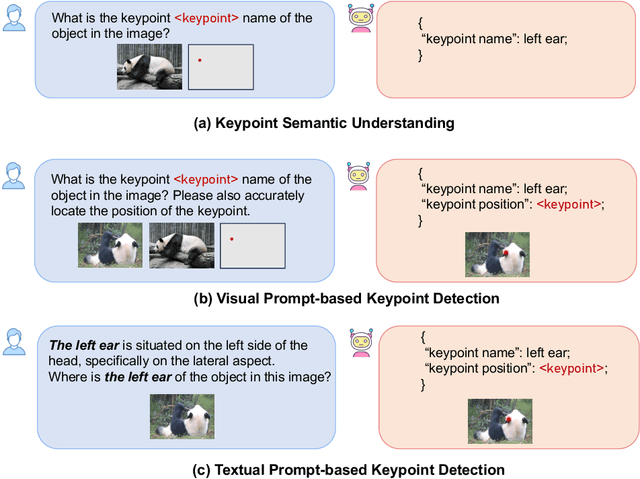


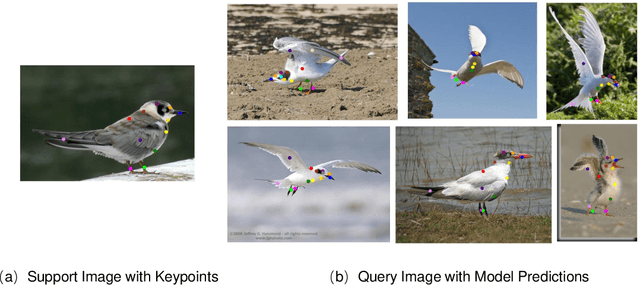
Abstract:Recent advancements in Multimodal Large Language Models (MLLMs) have greatly improved their abilities in image understanding. However, these models often struggle with grasping pixel-level semantic details, e.g., the keypoints of an object. To bridge this gap, we introduce the novel challenge of Semantic Keypoint Comprehension, which aims to comprehend keypoints across different task scenarios, including keypoint semantic understanding, visual prompt-based keypoint detection, and textual prompt-based keypoint detection. Moreover, we introduce KptLLM, a unified multimodal model that utilizes an identify-then-detect strategy to effectively address these challenges. KptLLM underscores the initial discernment of semantics in keypoints, followed by the precise determination of their positions through a chain-of-thought process. With several carefully designed modules, KptLLM adeptly handles various modality inputs, facilitating the interpretation of both semantic contents and keypoint locations. Our extensive experiments demonstrate KptLLM's superiority in various keypoint detection benchmarks and its unique semantic capabilities in interpreting keypoints.
PhoCoLens: Photorealistic and Consistent Reconstruction in Lensless Imaging
Sep 26, 2024



Abstract:Lensless cameras offer significant advantages in size, weight, and cost compared to traditional lens-based systems. Without a focusing lens, lensless cameras rely on computational algorithms to recover the scenes from multiplexed measurements. However, current algorithms struggle with inaccurate forward imaging models and insufficient priors to reconstruct high-quality images. To overcome these limitations, we introduce a novel two-stage approach for consistent and photorealistic lensless image reconstruction. The first stage of our approach ensures data consistency by focusing on accurately reconstructing the low-frequency content with a spatially varying deconvolution method that adjusts to changes in the Point Spread Function (PSF) across the camera's field of view. The second stage enhances photorealism by incorporating a generative prior from pre-trained diffusion models. By conditioning on the low-frequency content retrieved in the first stage, the diffusion model effectively reconstructs the high-frequency details that are typically lost in the lensless imaging process, while also maintaining image fidelity. Our method achieves a superior balance between data fidelity and visual quality compared to existing methods, as demonstrated with two popular lensless systems, PhlatCam and DiffuserCam. Project website: https://phocolens.github.io/.
CMM-Math: A Chinese Multimodal Math Dataset To Evaluate and Enhance the Mathematics Reasoning of Large Multimodal Models
Sep 04, 2024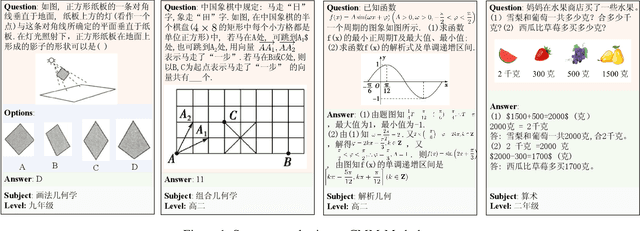
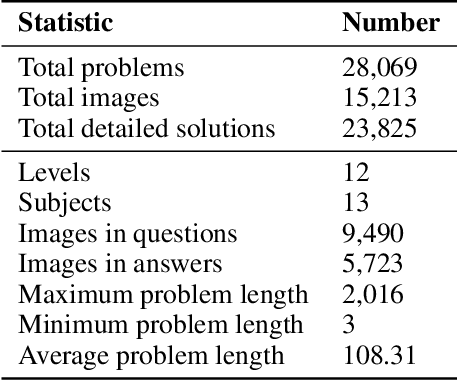
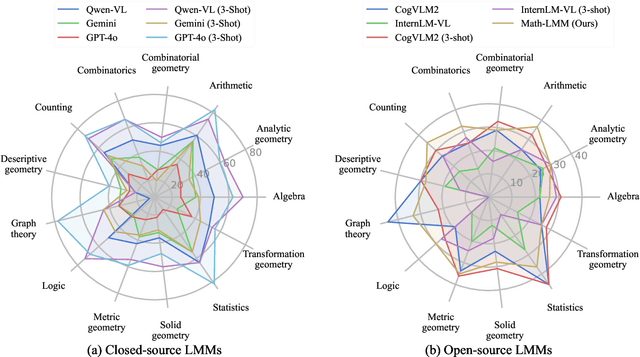
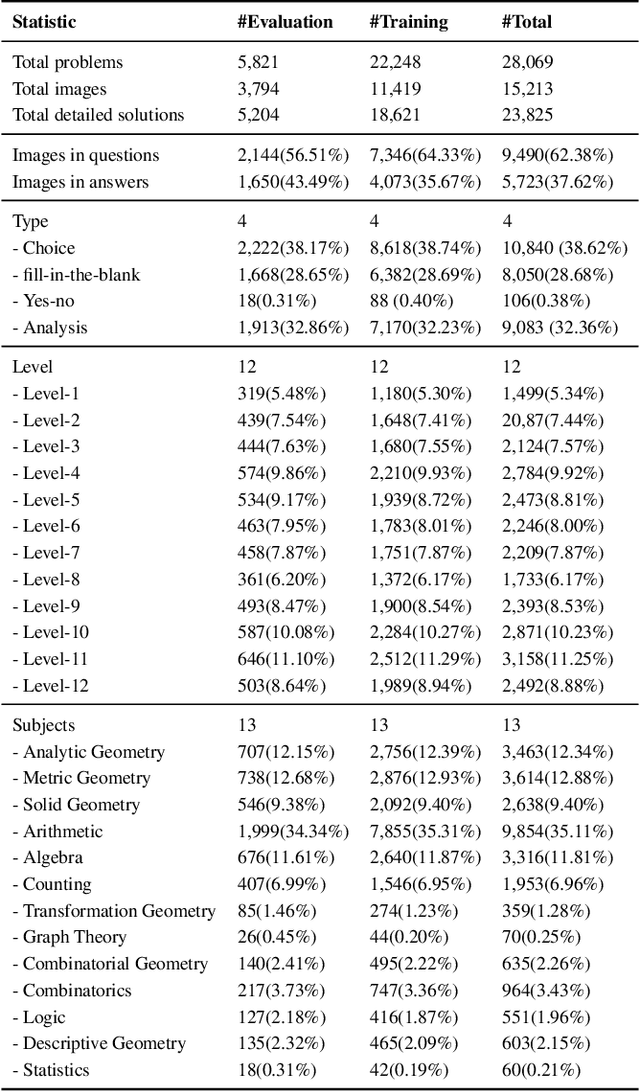
Abstract:Large language models (LLMs) have obtained promising results in mathematical reasoning, which is a foundational skill for human intelligence. Most previous studies focus on improving and measuring the performance of LLMs based on textual math reasoning datasets (e.g., MATH, GSM8K). Recently, a few researchers have released English multimodal math datasets (e.g., MATHVISTA and MATH-V) to evaluate the effectiveness of large multimodal models (LMMs). In this paper, we release a Chinese multimodal math (CMM-Math) dataset, including benchmark and training parts, to evaluate and enhance the mathematical reasoning of LMMs. CMM-Math contains over 28,000 high-quality samples, featuring a variety of problem types (e.g., multiple-choice, fill-in-the-blank, and so on) with detailed solutions across 12 grade levels from elementary to high school in China. Specifically, the visual context may be present in the questions or opinions, which makes this dataset more challenging. Through comprehensive analysis, we discover that state-of-the-art LMMs on the CMM-Math dataset face challenges, emphasizing the necessity for further improvements in LMM development. We also propose a Multimodal Mathematical LMM (Math-LMM) to handle the problems with mixed input of multiple images and text segments. We train our model using three stages, including foundational pre-training, foundational fine-tuning, and mathematical fine-tuning. The extensive experiments indicate that our model effectively improves math reasoning performance by comparing it with the SOTA LMMs over three multimodal mathematical datasets.
CAS-ViT: Convolutional Additive Self-attention Vision Transformers for Efficient Mobile Applications
Aug 07, 2024



Abstract:Vision Transformers (ViTs) mark a revolutionary advance in neural networks with their token mixer's powerful global context capability. However, the pairwise token affinity and complex matrix operations limit its deployment on resource-constrained scenarios and real-time applications, such as mobile devices, although considerable efforts have been made in previous works. In this paper, we introduce CAS-ViT: Convolutional Additive Self-attention Vision Transformers, to achieve a balance between efficiency and performance in mobile applications. Firstly, we argue that the capability of token mixers to obtain global contextual information hinges on multiple information interactions, such as spatial and channel domains. Subsequently, we construct a novel additive similarity function following this paradigm and present an efficient implementation named Convolutional Additive Token Mixer (CATM). This simplification leads to a significant reduction in computational overhead. We evaluate CAS-ViT across a variety of vision tasks, including image classification, object detection, instance segmentation, and semantic segmentation. Our experiments, conducted on GPUs, ONNX, and iPhones, demonstrate that CAS-ViT achieves a competitive performance when compared to other state-of-the-art backbones, establishing it as a viable option for efficient mobile vision applications. Our code and model are available at: \url{https://github.com/Tianfang-Zhang/CAS-ViT}
TCFormer: Visual Recognition via Token Clustering Transformer
Jul 16, 2024Abstract:Transformers are widely used in computer vision areas and have achieved remarkable success. Most state-of-the-art approaches split images into regular grids and represent each grid region with a vision token. However, fixed token distribution disregards the semantic meaning of different image regions, resulting in sub-optimal performance. To address this issue, we propose the Token Clustering Transformer (TCFormer), which generates dynamic vision tokens based on semantic meaning. Our dynamic tokens possess two crucial characteristics: (1) Representing image regions with similar semantic meanings using the same vision token, even if those regions are not adjacent, and (2) concentrating on regions with valuable details and represent them using fine tokens. Through extensive experimentation across various applications, including image classification, human pose estimation, semantic segmentation, and object detection, we demonstrate the effectiveness of our TCFormer. The code and models for this work are available at https://github.com/zengwang430521/TCFormer.
When Pedestrian Detection Meets Multi-Modal Learning: Generalist Model and Benchmark Dataset
Jul 14, 2024Abstract:Recent years have witnessed increasing research attention towards pedestrian detection by taking the advantages of different sensor modalities (e.g. RGB, IR, Depth, LiDAR and Event). However, designing a unified generalist model that can effectively process diverse sensor modalities remains a challenge. This paper introduces MMPedestron, a novel generalist model for multimodal perception. Unlike previous specialist models that only process one or a pair of specific modality inputs, MMPedestron is able to process multiple modal inputs and their dynamic combinations. The proposed approach comprises a unified encoder for modal representation and fusion and a general head for pedestrian detection. We introduce two extra learnable tokens, i.e. MAA and MAF, for adaptive multi-modal feature fusion. In addition, we construct the MMPD dataset, the first large-scale benchmark for multi-modal pedestrian detection. This benchmark incorporates existing public datasets and a newly collected dataset called EventPed, covering a wide range of sensor modalities including RGB, IR, Depth, LiDAR, and Event data. With multi-modal joint training, our model achieves state-of-the-art performance on a wide range of pedestrian detection benchmarks, surpassing leading models tailored for specific sensor modality. For example, it achieves 71.1 AP on COCO-Persons and 72.6 AP on LLVIP. Notably, our model achieves comparable performance to the InternImage-H model on CrowdHuman with 30x smaller parameters. Codes and data are available at https://github.com/BubblyYi/MMPedestron.
F-LMM: Grounding Frozen Large Multimodal Models
Jun 09, 2024



Abstract:Endowing Large Multimodal Models (LMMs) with visual grounding capability can significantly enhance AIs' understanding of the visual world and their interaction with humans. However, existing methods typically fine-tune the parameters of LMMs to learn additional segmentation tokens and overfit grounding and segmentation datasets. Such a design would inevitably cause a catastrophic diminution in the indispensable conversational capability of general AI assistants. In this paper, we comprehensively evaluate state-of-the-art grounding LMMs across a suite of multimodal question-answering benchmarks, observing pronounced performance drops that indicate vanishing general knowledge comprehension and weakened instruction following ability. To address this issue, we present F-LMM -- grounding frozen off-the-shelf LMMs in human-AI conversations -- a straightforward yet effective design based on the fact that word-pixel correspondences conducive to visual grounding inherently exist in the attention weights of well-trained LMMs. Using only a few trainable CNN layers, we can translate word-pixel attention weights to mask logits, which a SAM-based mask refiner can further optimise. Our F-LMM neither learns special segmentation tokens nor utilises high-quality grounded instruction-tuning data, but achieves competitive performance on referring expression segmentation and panoptic narrative grounding benchmarks while completely preserving LMMs' original conversational ability. Additionally, with instruction-following ability preserved and grounding ability obtained, our F-LMM can perform visual chain-of-thought reasoning and better resist object hallucinations.
 Add to Chrome
Add to Chrome Add to Firefox
Add to Firefox Add to Edge
Add to Edge